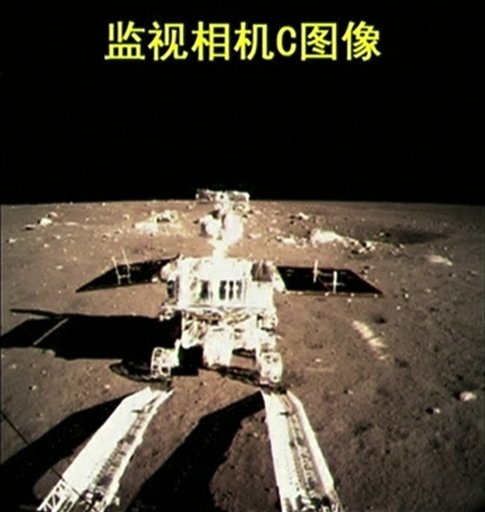(AP) China’s moon rover leaves traces on lunar soil
By LOUISE WATT
Associated Press
BEIJING
China’s first moon rover has touched the lunar surface and left deep traces on its loose soil, state media reported Sunday, several hours after the country successfully carried out the world’s first soft landing of a space probe on the moon in nearly four decades.
The 140-kilogram (300-pound) “Jade Rabbit” rover separated from the much larger landing vehicle early Sunday, around seven hours after the unmanned Chang’e 3 space probe touched down on a fairly flat, Earth-facing part of the moon.
State broadcaster China Central Television showed images taken from the lander’s camera of the rover and its shadow moving down a sloping ladder and touching the surface, setting off applause in the Beijing control center. It said the lander and rover, both bearing Chinese flags, would take photos of each other Sunday evening.
Later, the six-wheeled rover will survey the moon’s geological structure and surface and look for natural resources for three months, while the lander will carry out scientific explorations at the landing site for one year.
The mission marks the next stage in an ambitious space program that aims to eventually put a Chinese astronaut on the moon. China’s space program is an enormous source of pride for the country, the third to carry out a lunar soft landing _ which does not damage the craft and the equipment it carries _ after the United States and the former Soviet Union. The last one was by the Soviet Union in 1976.
On Saturday evening, CCTV showed a computer-generated image of the Chang’e 3 lander’s path as it approached the surface of the moon, saying that during the landing period it needed to have no contact with Earth. As it was just hundreds of meters (yards) away, the lander’s camera broadcast images of the moon’s surface.
The Chang’e 3’s solar panels, which are used to absorb sunlight to generate power, opened soon after the landing.
The mission blasted off from southwest China on Dec. 2 on a Long March-3B carrier rocket. It is named after a mythical Chinese goddess of the moon and the “Yutu” rover, or “Jade Rabbit” in English, is the goddess’ pet.
China’s military-backed space program has made methodical progress in a relatively short time, although it lags far behind the United States and Russia in technology and experience.
China sent its first astronaut into space in 2003, becoming the third nation after Russia and the United States to achieve manned space travel independently. In 2006, it sent its first probe to the moon. China plans to open a space station around 2020 and send an astronaut to the moon after that.

COMMENTS
Please let us know if you're having issues with commenting.